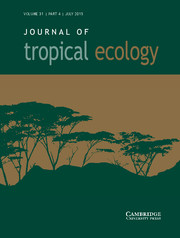Article contents
Using distance sampling with camera traps to estimate densities of ungulates on tropical oceanic islands
Published online by Cambridge University Press: 13 May 2025
Abstract
Reliable population estimates are one of the most elementary needs for the management of wildlife, particularly for introduced ungulates on oceanic islands. We aimed to produce accurate and precise density estimates of Philippine deer (Rusa marianna) and wild pigs (Sus scrofa) on Guam using motion-triggered cameras combined with distance sampling to estimate densities from observations of unmarked animals while accounting for imperfect detection. We used an automated digital data processing pipeline for species recognition and to estimate the distance to detected species. Our density estimates were slightly lower than published estimates, consistent with management to reduce populations. We estimated the number of camera traps needed to obtain a 0.1 coefficient of variation was substantial, requiring > ten-fold increase in camera traps, while estimates with precision of 0.2 or 0.3 were more achievable, requiring doubling to quadrupling the number of camera traps. We provide best practices for establishing and conducting distance sampling with camera trap surveys for density estimation based on lessons learned during this study. Future studies should consider distance sampling with camera traps to efficiently survey and monitor unmarked animals, particularly medium-sized ungulates, in tropical, oceanic island ecosystems.
Keywords
Information
- Type
- Research Article
- Information
- Creative Commons
- To the extent this is a work of the US Government, it is not subject to copyright protection within the United States. Published by Cambridge University Press.
- Copyright
- © United States Geological Survey (USGS) and U.S. Navy, 2025
Footnotes
Current address: NAVFACSYSCOM Pacific, Environmental Department, 258 Makalapa Dr, Ste 100, JBPHH, HI 96860-3134.
Current address: Yokosuka Navy Base, Public Works Division, Environmental Office, PSC 473 Box 3244, FPO AP 96349.
References
- 1
- Cited by


